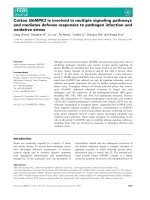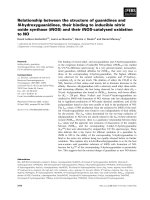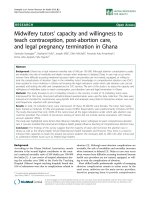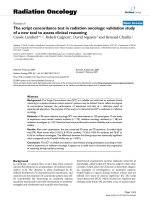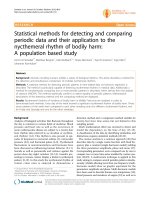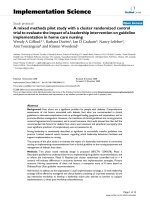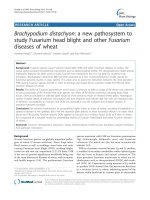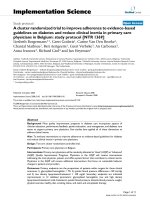New methods to study proline rich disordered regions and their structural ensembles in protein signaling pathways
Bạn đang xem bản rút gọn của tài liệu. Xem và tải ngay bản đầy đủ của tài liệu tại đây (3.11 MB, 190 trang )
NEW METHODS TO STUDY PROLINE-RICH
DISORDERED REGIONS AND THEIR STRUCTURAL
ENSEMBLES IN PROTEIN SIGNALING PATHWAYS
LIU CHENGCHENG
(B.Sci. (Hons), NUS)
A THESIS SUBMITTED
FOR THE DEGREE OF DOCTOR OF PHILOSOPHY
IN COMPUTATION AND SYSTEMS BIOLOGY
(CSB)
SINGAPORE-MIT ALLIANCE
NATIONAL UNIVERSITY OF SINGAPORE
2012
Acknowledgments
I would like to particularly thank my parents, who have given their full
support in my entire undergraduate and graduate studies.
I am very grateful to my two thesis supervisors, Christopher Hogue
and Michael Yaffe, both of whom gave me great inspiration and motivation in
my research topic. I am impressed with Chris’ novel and interesting insights in
research. I deeply thank Chris for all the kind guidance, suggestions, effort and
help throughout my entire PhD candidature, without which I could not have
learnt and achieved so many meaningful things in this significant phase of my
life. I truly give my thanks to Mike for his dedicated supervision and
encouragement especially during my exchange at MIT. I would like to thank
my qualifying examination committee members, Boon Chuan Low, Steve
Rosen, Jianzhu Chen, who gave me great suggestions and advice in my thesis
project. I also want to thank other SMA faculty, including Zhiyuan Gong,
Chwee Teck Lim, Jie Yan and Sourav Saha Bhowmick, for their help and
support. I thank for the encouragement from Lisa Tucker-Kellogg, Hanry Yu,
and Yuzong Chen when I felt depressed in my study.
The work about molecular simulation of LRP6 intracellular domain in
Chapter 1 of this thesis received inspiration about the simulation study of
protein ActA, which was conducted by Mingxi Yao, a member of Hogue Lab
and a graduate student in Mechanobiology Institute, Singapore. I thank Mingxi
for all the helpful discussions and suggestions.
iii
In Chapter 2 of this thesis, the work received from the help of Sihan
Liu, a former SMA PhD candidate, and I thank him for the technical support.
The work in Chapter 3 was conducted in collaboration with Brian
Joughin, a member of Yaffe Lab and a Research Scientist in David H. Koch
Institute for Integrative Cancer Research at MIT. I am very grateful to Brian
for his unique insights in the study of kinase-substrate specificity and other
topics in computational biology.
Additionally, I would like to sincerely thank Narendra Suhas
Jagannathan, Arun Chandramohan, Chen Zhao, Wenwei Xiang as well as
other members in the Hogue Lab for their useful discussions. Furthermore, I
extend my gratitude to the members in Yaffe lab, Dan Lim, Kylie Huang, Erik
Wilker and so on, for their kind help when I was at MIT.
I had all the fun and joy with my fellow SMA-CSB classmates,
Yingting Wu, Yujing Liu, Lu Huang, Huipeng Li, Lingbo Zhang and others.
Finally, I thank the financial support from Singapore-MIT Alliance and
Mechanobiology Institute, Singapore.
iv
Table of Contents
1 Introduction 1
2 The Effect of Spatial Constraints on An Ensemble of Proline-Rich
Disordered Structures 41
2.1 Background 42
2.2 Results 47
2.2.1 LRP6 intracellular domain is predicted to be unfolded. 47
2.2.2 Radius of gyration distribution 47
2.2.3 End-to-end distance distribution 54
2.3 Discussion 58
2.3.1 LRP6 intracellular domain structure ensemble favors an elongated
form when the Wnt/β-catenin canonical pathway initiates. 58
2.3.2 Effects of the two spatial constraints 61
2.3.3 Elongation makes the phosphorylation of unfolded protein regions
easier. 64
2.4 Conclusions 69
2.5 Methods 71
2.5.1 Generation of conformers of LRP6 intracellular domain 71
2.5.2 Filtration of structural ensemble of LRP6 intracellular domain 72
2.5.3 Measurement 75
2.5.4 The Rgyr distribution and end-to-end distance distribution 76
2.5.5 Control experiment 76
2.5.6 Program development 77
2.5.7 Simulation procedure using structure [PDB:1CMK] 78
2.6 Acknowledgements 80
2.7 Author’s Contributions 80
3 Sequence Detection of Proline/Serine-Rich Disordered Regions 81
3.1 Background 82
3.2 Implementation 85
3.2.1 Pro/Ser-rich disorder dataset 85
3.2.2 Third party datasets 86
3.2.3 The PSR index 87
3.2.4 Pro/Ser-rich disorder prediction 89
3.2.5 Prediction performance measures 89
v
3.2.6 Armadillo (2.0) 90
3.3 Results and Discussion 90
3.3.1 Amino acid composition in the datasets 90
3.3.2 Evaluation of Pro/Ser-rich disorder predictions 96
3.3.3 Server prediction examples 99
3.4 Conclusions 102
3.5 Author’s Contributions 102
4 Sequence Analysis of Interpositional Dependence in Phosphorylation Motifs
103
4.1 Background 104
4.2 Results 108
4.2.1 Statistical significance of interpositional dependencies among
kinase phosphorylation motifs 108
4.2.2 Incorporation of interpositional dependencies in predicting novel
kinase phosphorylation sites 112
4.3 Discussion 120
4.4 Conclusion 125
4.5 Methods 126
4.5.1 Data sources 126
4.5.2 Data preparation 126
4.5.3 Simplified amino acid alphabet 128
4.5.4 Statistical analysis of enriched and reduced amino acid pairs. 128
4.5.5 Statistical significance cutoff determination 131
4.5.6 First and second-order model prediction 132
4.5.7 Evaluation of first-and second-order models 133
4.6 Acknowledgement 136
4.7 Author’s Contributions 136
5 Conclusions and Fuure Directions 137
vi
Summary
In signaling and mechano-related pathways, a type of protein domain is
critical for transducing signals. Such protein domains are located in the termini
or flanked by folded domains, compositional biased with prolines preventing
folding into a single stable conformation. They are referred as proline-rich
disordered protein regions. This thesis presents a couple of new methods using
molecular simulation, bioinformatics and statistical analysis to study the
structural ensemble and sequences of proline-rich disordered regions. A new
approach, involving simulating the membrane or nearby molecular assembly
in the cellular context as simple planes in the conformational space of
disordered protein regions, is described in the sampling structural ensembles
of proline-rich disordered LRP6 intracellular domain in the initiation of
Wnt/β-catenin pathway. The new simulation approach shows that an elongated
form dominates the conformational space of such proline-rich disordered
regions when assembled with membranes or neighbor molecules that impose
excluded volume constraints. A new amino acid propensity index called PSR
is derived from a set of folded domains and a set of proline/serine-rich
disordered regions. This index is used to predict long proline-rich disordered
regions containing multiple serines, which could serve as phosphoacceptors in
signaling pathways. New statistical analysis was done to further study the
kinase-substrate specificity for kinases ATM/ATR, CDK1 and CK2, by
including the second-order interpositional sequence dependence in the
substrate phosphorylation peptides. The findings show that sequence alone is
not sufficient to improve the accuracy of phosphorylation sites prediction for
the kinases studied; instead, other parameters, especially co-localization,
vii
surface accessibility etc, are required to be considered. This study can be
extended to other kinases.
viii
List of Tables
Table 1.1: Experimental methods for characterizing intrinsically disordered
proteins 6
Table 1.2: A list of current disorder predictors with available URL and brief
description 8
Table 1.3: Modular domains, phosphopeptide-binding domains and their
specificities. 28
Table 1.4: Proline-rich regions with repeated proline-rich motifs. 29
Table 1.5: Proline-rich regions without repeated proline-rich motifs. 30
Table 2.1: Rgyr simulation results for LRP6 intracellular domain 52
Table 2.2: Rgyr simulation results for control sequence. 52
Table 2.3: End-to-end distance simulation results for LRP6 intracellular
domain. 55
Table 2.4: T-test results on the constructed 100mer peptide. 69
Table 3.1: Calculated frequencies of amino acid residues in Pro/Ser-rich
disorder dataset and MMDB-I domain dataset as well as the negative and
normalized log ratios for PSR index. 88
Table 3.2: Amino acid composition difference in percentage between MMDB-
I domain dataset and disordered protein segments in DisProt (v5.8). 92
Table 3.3: Amino acid composition difference in percentage between MMDB-
I domain dataset and the curated Pro/Ser-rich disorder dataset from literature.
93
Table 3.4: Amino acid composition difference in percentage between MMDB-
I linker dataset and disordered protein segments in DisProt (v5.8). 94
Table 3.5: Pro/Ser-rich disorder predictions. 98
Table 4.1: A list of current phosphorylation site predictors. 107
Table4.2: Substrate sequence position pairs demonstrating significant
deviations from independence. 111
ix
List of Figures
Figure 1.1: The protein sequence-structure-function paradigm. 3
Figure 2.1: Two proposed initiation models of canonical Wnt/β-catenin
signalling pathways. 44
Figure 2.2: Analysis of the human LRP6 protein [Swiss-Prot:O75581] using
different predictors. 49
Figure 2.3: Rgyr distribution of the initial conformational ensemble before
filtration 50
Figure 2.4: Rgyr distributions of LRP6 ICD and control sequence. 53
Figure 2.5: End-to-end distance distributions of D1 for LRP6 ICD and control
sequence 56
Figure 2.6: End-to-end distance distributions of D2, D3, D4 and D5 for LRP6
ICD and control sequence. 57
Figure 2.7: Simulation results from the study on structure [PDB:1CMK]. 67
Figure 2.8: Rgyr and end-to-end distance distributions of D1-40, D31-70 and
D61-100 for the constructed 100mer alternating Pro/Ser peptide with substrate
phosphorylation motif in the centre. 68
Figure 2.9: Flow chart of the simulation process on LRP6 intracellular domain.
78
Figure 3.1: Amino acid compositions of the datasets. 95
Figure 3.2: Armadillo (2.0) Pro/Ser-rich disorder predictions for human
proteins LRP6, WASP and MAP tau isoform 2. 101
Figure 4.1: Comparison of ability of first- and second- order models to
identify kinase substrates. 118
Figure 4.2: Comparison of ability of first- and second- order models to
correctly identify true positives, correcting for occurrence of amino acid pairs
not present among training data. 119
Figure 4.3: Model evolutionary fitness landscapes for substrates of kinases and
phosphopeptide-binding domains 124
Figure 4.4: Data source and data preparation. 127
Figure 4.5: Motif logos for substrates analyzed. 129
Figure 4.6: ROC curves detail variation of true and false positive rates with
probability score. 135
x
List of Illustrations
Illustration 1.1: An illustration of energy landscape models for globular/folded
proteins and intrinsically disordered/unfolded proteins. 15
Illustration 2.1: Illustration of the spatial constraints. 74
Illustration 4.1: An illustration of statistical hypothesis testing as applied in
this analysis. 130
xi
List of Symbols
Radius of Gyration (Å)
Position of individual atoms of the structure ( )
Mean position of all atoms of the structure ( )
Frequency of amino acid aa in dataset s ( )
Occurrence of amino acid aa in dataset s ( )
PSR index of amino acid aa ( )
Probability for Enrichment of an amino acid pair ( )
Probability for Reduction of an amino acid pair ( )
Probability of an m length of sequence in first-order model ( )
Probability of an m length of sequence in second-order model ( )
1
Chapter 1
Introduction
Defining Protein Disorder
More than a century ago, the discovery about the structural fitness between an
enzyme and a substrate led to the formation of the famous “lock and key”
hypothesis, in which, the substrate (key) must possess a specific conformation
to dock into the catalytic site (key-hole) of an enzyme (lock) [1]. The
associated sequence-structure-function paradigm of protein folding states that
the sequence of a protein determines its native three-dimensional structure in
an aqueous environment, and a protein folds into a defined, stable and rigid
three-dimensional structure to fulfill its functional purpose [2, 3]. The folding
hypothesis has been demonstrated by a tremendous number of identified X-ray
crystal structures and nuclear magnetic resonance conformers deposited in the
Protein Data Bank (PDB) [4-9]. While many early scientists were aware that
some protein sequences may not fold into such definite structures, the protein
folding paradigm dominated our understanding of structure-function
relationships. Now we are more aware of the significant fraction of proteins
with native biological functions but that lack folded structure, either in their
entirety or in portions. The evidence arises from proteins that either do not
crystallize under any conditions, or whose determined structures have missing
electron densities in X-ray diffraction, or that do not have stable defined
structure in solution in nuclear magnetic resonance (NMR) spectrometry [10-
27]. These flexible and disordered proteins or regions simply lack a unique
folded conformation. They are frequently referred as flexible, mobile, partially
2
folded, natively denatured [28], natively unfolded [29, 30], intrinsically
unstructured [31, 32], and recently a more common term, intrinsically
disordered [33] (Figure 1.1). The definition of intrinsic disorder is clarified as
regions in the protein structure where the equilibrium position of the backbone
along with the dihedral angles, has no specific values and vary significantly
over time [33, 34]. How can we describe such proteins? For the purpose of
clarification, the conformational states that are available to proteins are
defined here. First, the native state is a protein’s observable conformation
related to its biological functions [35]. A native state is often a folded state,
which is structured and ordered [36] typically with common elements of
protein folds such as secondary structure and a hydrophobic core. Yet, the
native state of a protein sequence is not necessarily folded [37]; sometimes, it
is rather an unfolded state, which is unstructured or disordered, not restricted
to be a random coil, but possibly also consisting of extended disorder (pre-
molten globule) and collapsed disorder (molten globule) [33, 38] components.
If a protein’s unfolded state is obtained through chemical denaturation, for
example in high concentrations of urea, or at high temperature, such a state is
normally referred as the denatured state, which is itself a non-native state [35].
Denatured states have common unstructured properties with intrinsically
disordered proteins (IDPs), but the details of the types of conformations
observed may differ. For over five decades Intrinsically Disordered Proteins
by any name, have been considered to be mysterious as their structural
features have remained evasive. Recent improvements in both experimental
techniques and computational approaches are starting to improve our
understanding of all forms of protein disorder.
3
Figure 1.1: The protein sequence-structure-function paradigm.
Experimental Characterization
Most traditional experimental methods have limited abilities to characterize
the 3-dimensional structure of intrinsically disordered proteins. NMR
spectroscopy and circular dichroism (CD) spectropolarimetry [33] are the
most useful of these. There are no examples of full-length disordered proteins
that can be crystallized from solution thus their structures cannot be detected
by X-ray crystallography, however small regions of disorder can be detected
by the absence of data. For proteins having both ordered and disordered
regions, they are able to crystallize on account of the ordered regions’
crystallization. Disordered regions give incoherent X-ray scattering resulting
in missing electron density [17, 39-44].
NMR is able to characterize protein disordered regions, transient
secondary and tertiary structures as well. It can also be used to study the
structure in a dynamic way [45-55]. A set of biophysical terms can be
measured from NMR experiments including chemical shifts [56-58], scalar
4
couplings [59], residual dipolar couplings (RDCs) [60-64], and paramagnetic
relaxation enhancement (PRE) effects [65]. These biophysical terms can often
be expressed in terms of bond angle or atom distance information, and then
used as restraints for fitting coordinate models of disordered proteins.
Molecular simulations are necessary to generate examples of the
conformational space that may be explored by disordered proteins, after which
the associated NMR restraints can be applied to refine the models that fit the
experimental data. Chemical shifts are the atoms’ unique frequencies specified
in the resonance spectrum. The deviation from random coil to helix and beta
strand conformations can be determined by tables of chemical shift, and these
inform us of evidence of local secondary structures [66-69]. Scalar couplings
can inform us of the observed backbone dihedral angels in a protein structure.
RDCs report the information about the bond angles and vectors relative to the
core structure. PRE effects can provide long-range distance restraints.
CD identifies disordered proteins by measurement of low intensity
near-UV backbone optical polarization information, which can be compared to
standard protein folds. Deviation from folded backbone conformations can
show a protein is intrinsically disordered [70, 71]. Other important techniques
include small angle X-ray scattering (SAXS), hydrodynamic measurements
such as size exclusion chromatography, infrared spectroscopy, fluorescence
resonance energy transfer (FRET), conformational stability with effects of
temperature and pH, mass spectrometry-based high resolution hydrogen-
deuterium exchange, protease sensitivity and optical rotary dispersion (ORD).
Table 1.1 provides a list of current experimental techniques for intrinsic
disorder characterization.
5
SAXS can be applied to evaluate the size of protein structure in
solution, which is then compared to its globular form with features like the
signal changes at higher scattering angles, radius of gyration (Rgyr) and
maximum dimension [72-75]. FRET captures the structural state by measuring
the distance distribution between the donor and acceptor chromophores [76-
79]. Taken together, these experimental measurements, especially from NMR
[56-65] , SAXS [80-82] and FRET [83-85], can often be used as sources for
constructing ensembles for disordered proteins as fill in structural information
missing from disordered regions. However the structures that result from these
are often represented as an ensemble of 3-dimensional disordered structures,
with some number of static structures that demonstrate the range of
conformational variants that may fit the experimental data. The ensemble is
implied to represent “snapshots” of the protein as it may dynamically meander
and explore its native disordered states.
A combination of multiple experimental techniques will give more
information about the identification and conformational states of intrinsic
disorder over a single technique. Many experimentally identified disordered
protein regions arising from conventional structures have been deposited into a
database called DisProt [86]. However, difficulties exist in identifying
sequence with intrinsic disorder, by a myriad of effects for example structural
experimentation nuance of structure definition, protein expression, and
reagents. A number of computational tools have been applied to the problem
of identifying the specific regions that exhibit intrinsic disorder, which are
becoming more helpful in working with intrinsic disordered proteins.
6
Table 1.1: Experimental methods for characterizing intrinsically disordered
proteins
Major Experimental Methods For Study of Intrinsic Disordered Proteins
X-Ray Chrystallorgraphy
Nuclear Magnetic Resonance (NMR) Spectroscopy
Small Angle X-ray Diffraction (SAXS)
Circular Dichroism (CD) Spectropolarimetry
Infrared Spectroscopy
Fluorescence Resonance Energy Transfer (FRET)
Size Exclusion Chromatography
Native Acrylamide Gel Electrophoresis
Conformational Stability (through Temperature or PH)
Mass Spectrometry-Based High Resolution
Hydrogen-Deuterium Exchange
Protease Sensitivity
Computational Prediction
R.J.P Williams proposed the first disorder predictor in 1979 based on the
extremely high ratio between the number of charged residues and the number
of hydrophobic resides [87, 88]. Secondary structure prediction algorithms
starting with the GOR (Garnier, Osguthorpe, Robson) [89-92] indicated a
fractional prediction of percent “coil” which may be interpreted as a lack of
secondary structure and therefore a disordered region, however these tools
were never widely used or tested with modern disordered datasets. The first
well defined disorder predictors PONDRs using artificial neural network
algorithms were developed by the research group of Dunker, Obradovic and
Uversky [30, 42, 93-102]. To date more than 50 computational approaches
have been designed to discover disordered regions along protein sequences.
Many of these predictors have online servers. Table 1.2 provides a series of
current disorder predictors in details. These methods are discussed thoroughly
in many review articles [103-106]. Disorder prediction was included in the
7
biennial Critical Assessment of Structure Prediction (CASP) since 2004 [107-
111] which focuses on identification of structurally characterized small
regions of disorder. This assessment brings further advancement in the
development of disorder predictor design. At the same time, disorder
predictors can give feedback to experimental protocols for accurate
identification of intrinsic disorder. Among the published disorder predictors,
such as , PONDRs [93, 96, 98, 101, 102, 112, 113], DISOPRED [114, 115],
RONN [116] and POODLE [117-120], machine learning algorithms including
neural networks (NN) and support vector machines (SVMs) are used as the
basic methods. The input features used in training these algorithms are largely
different from each other, including amino acid composition, net charge,
predicted secondary structure, and hydropathy. Some predictors, such as
GlobPlot [121] and IUPred [122, 123], use rather simple algorithms, yet they
are able to effectively predict disordered regions. Some of the predictors have
improved their efficiency through modifications. A number of metaprediction
servers have also been developed, integrating different disorder predictors into
a consensus prediction. Examples of metaprediction servers include
DisPSSMP2 [124], PrDOS [125], MD [126], MFDp [127], GSmetaDisorder
[128], which are generally able to produce better prediction results.
Fundamentally, disorder predictors all rely on the properties of disordered
regions that can be understood as amino acid compositional and contextual
differences between ordered and disordered proteins.
8
Table 1.2: A list of current disorder predictors with available URL and brief description. Table adapted by author from [103-105].
Predictor
Publication
year
Brief description
SEG[129]
1994
SEG predicts low-complexity or compositional biased segments as well as non-
globular domains. For predicting long and short non-globular domains, different
parameters must be used. SEG is not trained as a disorder predictor, but as there is a
correspondence between low-complexity sequence and disorder, often finds disordered
regions.
HCA (Hydrophobic Cluster Analysis)[130]
1997
HCA predicts hydrophobic clusters, which tend to form secondary structure elements.
This method is based on a helical visualization of amino acid sequence. The prediction
output can display coiled coils, compositional biased regions and boundaries of
disordered proteins.
PONDR (XL1, VL1, XL-XT, VL2, VL3, VSL1, VSL2) [93,
96, 98, 101, 112, 113]
1997-2006
PONDRs includes a series of predictors which can predict disordered regions. The
types of disordered regions predicted by PONDR predictors include random coils,
partially unstructured regions, and molten globules. It is trained with local amino acid
composition, flexibility, hydropathy etc, using feed-forward neural network. These
predictors perform well in disorder prediction as shown in many applications.
Charge/hydropathy method[30]
2000
Charge/hydropathy method predicts fully unstructured domains (random coils) based
on global sequence composition (hydrophobicity versus net charge). This method is
expected to identify disordered regions that are not present in DisProt. Prior knowledge
of modular organization of protein is required. It is only applicable to domains without
disulfide bonds and without metal-binding regions.
GlobPlot [121]
2003
GlobPlot predicts regions with high propensity for globularity based on the
Russell/Linding scale [121], which describes the relative propensity of an amino acid
residue to be in an ordered (secondary structure) or disordered (random coil) state. The
output provides an overview of modular organization of large proteins and shows
changes of slope corresponding to domain boundaries. GlobPlot is user-friendly with
built-in SMART, PFAM and low-complexity predictions.
DisEMBL[131]
2003
DisEMBL is able to predict three kinds of disordered structure, including loops/coils
(regions devoid of regular secondary structures), hot loops (highly mobile loops), and
those that are missing from the PDB X-ray structures (REMARK465). The neural
networks were trained with X-ray structure data. DisEMBL also displays the low-
complexity regions and propensity of aggregation. Prediction using loops/coils
predictor is most trusted.
9
NORSp[132]
2003
NORSp predicts regions with No Ordered Regular Secondary (NORS) structure, most
of which are highly flexible. It is based on secondary structure and solvent
accessibility. NORSp generates and uses multiple sequence alignment. Some highly
flexible regions are yet predicted to contain secondary structures.
DISOPRED [114]
DISOPRED2 [115]
2003
DISOPRED trains the whole sequence information using neural networks.
2004
DISOPRED2 is trained with PSI-BLAST profiles using cascaded support vector
machine (SVM) classifiers and generates and uses multiple sequence alignment. It
predicts regions lack of ordered regular secondary structure. However, when there are
few homologues, the prediction accuracy is lower.
Weather’s method [133]
2004
Weather’s method uses SVM analysis of a linear combination of composition vectors.
DRIPPRED [134]
2004
DRIPPRED is based on Kohonen’s self-organizing map and received a good evaluation
at CASP6.
FoldUnfold [135-137]
2004
FoldUnfold is based on the idea that the structure of proteins is governed by the
balance between the interaction energy of residues and their conformational entropy.
IUPred[122, 123]
2005
IUPred predicts regions that lack a well-defined 3D structure under native conditions. It
is based on the idea that the energy resulting from inter-residue interactions is
responsible for determining whether a protein forms structure or not. This method is
expected to identify disordered proteins that are not present in DisProt and only
applicable to proteins without disulfide bonds and without metal-binding regions.
RONN [116]
2005
RONN predicts regions that are lack of a well-defined 3D structure under native
conditions. It trains on disordered proteins using bio-basis function neural network.
RONN is restricted to search for short regions of disorder.
DISpro[138]
2005
DISpro is based on a one dimensional recursive neural network (1D-RNN) model, the
flexibility of Bayesian model and a fast, convenient, parameterization of an artificial
neural network (ANN).
FoldIndex [139]
2005
FoldIndex is used to analyze the ratio of net charge with hydropathy locally using a
sliding window. It predicts regions that have a low hydrophobicity and high net charge
(loops or unstructured regions). FoldIndex provides prediction on probable short loops
but no prediction on N- and C-termini.
PreLink[140]
2005
PreLink predicts regions that are expected to be unstructured in all conditions,
regardless of the presence of a binding partner. It is based on compositional bias and
low hydrophobic cluster content.
Spritz [141]
2006
Spritz consists of two specialized binary classifiers, one for short disordered regions
and the other for long disordered fragments.
IUP[142]
2006
IUP is based on a Recursive Maximum Contrast Tree (RMCT) to recognize
intrinsically disordered regions.
10
DisPSSMP[143]
DisPSSMP2[124]
2006
DisPSSMP is based on Radial Basis Function Networks with inputs from position-
specific scoring matrices and other sequence properties.
2007
DisPSSMP2 uses a two-level prediction scheme and a condensed position-specific
scoring matrix.
NORSnet [144]
2007
NORSnet uses feed-forward neural networks.
POODLE-S[118]
2007
POODEL-S is a group of seven SVM predictors with each responsible for a specific
region of the whole sequence.
POODLE-L [117]
POODLE-L is composed of ten two-level SVM predictors.
POODLE-W [119]
POODLE-W predicts disordered structures by using a Spectral Graph Transducer
(SGT) and by training with a huge amount of structure-unknown sequences.
PrDOS[125]
2007
PrDOS consists of two predictors, one of which uses the alignment of homologs.
metaPrDOS[145]
2008
MetaPrDOS is composed of seven individual predictors which areas follow: PrDOS,
DISOPRED2, DisEMBL, DISPROT, DISpro, IUPred, and POODLE-S.
Bayes[146]
2008
Bayesian method computes the conditional probability of a sequence from a certain
class and then infers the posterior probability of the class.
OnD-CRFs[147]
2008
Conditional Random Fields (CRFs) method predicts the intrinsic disorder in proteins.
CRF is a discriminatively supervised machine-learning method.
DISOclust[148]
2008
DISOclust applies the principle that ordered residues within a protein target should be
conserved in three-dimensional space within multiple models, whereas the residues that
vary or are consistently missing may be correlated with the disordered structure.
MD [126]
2009
MD is a meta predictor composed of NORSnet, Ucon, PROFBval, DISOPRED2,
IUPred, and FoldIndex.
CDF-ALL[149]
2009
CDF-ALL is a protein-level disorder meta predictor composed of CDFs from VLXT,
VSL2, VL3, TopIDP, IUPred, and FoldIndex.
PreDisorder[150]
2009
PreDisorder uses a 1D recursive neural network with the input of a profile generated
from PSI-BLAST, the predicted secondary structure and solvent accessibility.
POODLE-I[120]
2010
POODLE-I is a meta predictor integrating POODLE-S, POODLE-L and POODLE-W.
PONDR-FIT[102]
www.disprot.org
2010
PONDR-FIT is a meta predictor that is trained using ANN with the results of
PONDRVLXT, VL3, VSL2, IUPred, FoldIndex and TopIDP.
MFDp[127]
2010
MFDp is a meta predictor consisting of DISOPRED2, DISOclust, and IUPred. Other
information, for example, PSSM, residue flexibility and back-bone dihedral torsion
angles, etc are taken as input.
11
IsUnstruct[151]
2011
IsUnstruct is developed using Ising model which involves an estimation of the energy
of the border between ordered and disordered regions.
DisCon[152]
2011
DisCon is based on a ridge regression model with the input of information on sequence,
evolutionary profiles, and so forth.
DICHOT[153, 154]
2011
DICHOT system combines structural domain identification, DISOPRED2 disorder
prediction and CLADIST classification program to predict structural domains and
intrinsically disordered regions.
GSmetaDisorder[128]
2012
GSmetaDisorder is a meta predictor that combines 12 disorder predictors: DisEMbL,
DISOPRED2, DISpro, GlobPlot, iPDA, IUPred, Pdisorder, POODLE-S, PrDOS,
Spritz, DisPSSMP and RONN.
CH-CDF plot[155]
2012
CH-CDF plot method is a combination of two methods: Charge/hydropathy and CDF-
ALL. It is able to predict proteins into four categories: structured, mixed, disordered
and rare.
SPINE-D[156]
2012
SPINE-D is based on a single neural network to predict if the residues are ordered or
disordered and if they are in short or long disordered regions. Its evaluation was among
the top servers in CASP9.
12
Studies have been carried out to learn about the difference in the amino
acid compositions between ordered and disordered proteins using the
sequences in DisProt. According to variation compared to DisProt, disordered
regions contain higher percentages of disorder-promoting amino acids (A, G,
R, Q, K, S, E and P) and lower percentages of order-promoting amino acids
(W, F, Y, I, L, V, N and C) compared to the ordered regions [33, 96, 157-159].
This peculiarity in amino acid composition explains that disorder regions have
overall low hydrophobicity and high net charge [30]. The sequence
composition and order influence other biophysical properties of disordered
regions, for example, flexibility index, helix propensities and strand
propensities [157]. These biophysical properties together with amino acid
sequence are treated as input features in the development of various sequence-
based disorder predictors as discussed above and in Table 1.2. An amino acid
scale was derived for better discrimination of order and disorder. The twenty
residues are ranked according to their tendencies of promoting order to
disorder as the following: W,F,Y,I,M,L,V,N,C,T,A,G,R,D,H,Q,K,S,E,P [160].
Note however that this ranking can be counter-intuitive. For example, glycine
has the largest conformational space variation and would be expected to be on
the extreme end of disorder promotion. Proline has the smallest
conformational space and would be expected to be order promoting on that
basis. However there is no simple correspondence between individual amino
acid properties and structure disorder, simply because it is dependent on the
context of neighboring residues and whether the sequence evolved some
folded structure. Depending on the properties of the R-group in each residue,
the twenty standard amino acids can be classified into several groups: non-
13
polar aliphatic (G, A, V, L, M and I), non-polar aromatic (F, Y and W), polar
acidic (L, R and H), polar basic (D and E) and polar uncharged (S, T, C, P, N
and Q). The aromatic residues (W, F and Y) as well as the bulky hydrophobic
residues (I, L and V) are preferred in the hydrophobic core of folded globular
domains. Thus, these residues are grouped into the order-promoting residues.
Earlier studies show that low-complexity in amino acid composition infers the
non-globular domains of proteins [161, 162]. A sequence is said to be of low-
complexity if it is biased in local composition to one or more amino acids
beyond what is expected in a normal sequence distribution. While low-
complexity regions are often also intrinsically disordered, some are not, and
some disordered regions fail to be detected by low-complexity locating
software such as SEG [129]. It has been reported that amino acid composition
alone cannot predict short-disordered regions (<=30 residues) effectively, but
it is adequate to predict long-disordered regions (> 30 residues) accurately.
Rauscher and Pomes [163] argued that for a protein polypeptide, when its
sequence length increases, the amino acid composition is a sufficient criterion
to predict long disorder regions, and at the same time, the sequence context
become less important [163, 164].
Molecular Simulation
In order to understand how the conformations of intrinsically disordered
proteins behave, ensembles are created by various means computational
simulation together with restraint fitting as previously mentioned. The tools
for molecular simulation are largely biased by a focus on structured proteins,

